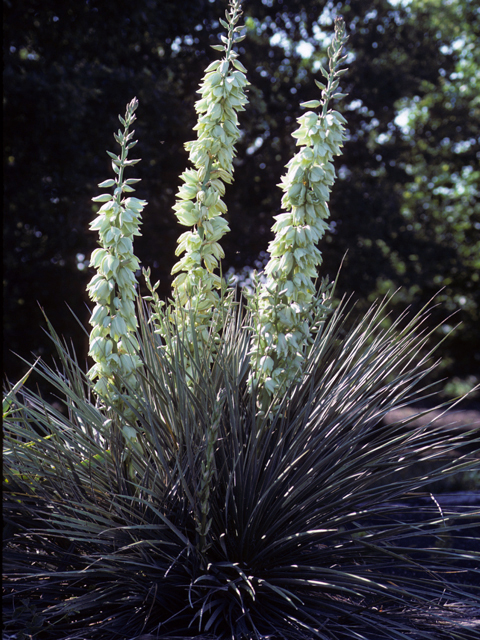 |
| Click the badge to visit the other bloggers. |
Okay S is a really hard one for me. Not because it is hard to find an S plant, but because there are too many interesting S plants. But one of the most interesting has to be the "Spanish Dagger" Yucca treculeana. Not because it is a beautiful flower, even if it is, but because of its unique relationship with its pollinator the Yucca Moth. Their relationship is such that one cannot live without the other. The small short lived moth does not have a long tongue like other moths and butterflies, but has testicles under its chin. The adult life is so brief they don't eat. After emerging from their cocoon, the male and female meet and mate in the blooms of the plant. The female then scraps up pollen from the flower of the Yucca and holds it under her chin. She then flies to another flower on another plant and searches for a flower in the right stage of bloom. She checks to make sure no eggs are already laid in the flowers ovary. The females can smell the scent of other females. If another female has laid eggs, she moves on to another flower. If too many eggs are laid in a blossom the plant will get rid of the flower and the eggs will die. So the female make sure of the survival of her offspring by laying only a limited number of eggs per flower. After she has laid the eggs, she goes to the stigma of the flower and spreads the pollen she collected on it to ensure pollination.
The flowering months of the "Spanish Dagger" is only 2 months March and April. The plant grows in the deep south of Texas.
 |
| Picture from the Wasowski Collection at Wildflower.org |
 |
| Tegeticula sp. Photo by M.J. Hatfield, BugGuide.net |
One other very interesting plant in S is the "Spotted Beebalm" Monarda punctata var. lasiodonta. All the Beebalms have a strong fragence when brushed or crushed (Lemon Beebalm can be used to repel mosquitoes). This version of the Beebalm or Horsemint has a strong fragrance of thyme and has the antiseptic compound thymol. This compound has been used in cough syrups and in the past has been used for the commercial source. This plant can be found in most of Texas except the extremly dry areas of West-central, West and Deep South Texas. The Beebalms bloom from April through August.
 |
| Picture from University of Texas Plant Resource Center |
I had to show the pictures of these beauties as well. The information can be looked up on the UT Library
here.
Southern Lady's Slipper Cypripedium kentuckiensis
 |
| Picture from University of Texas Plant Resource Center |
Strawberry Cactus Echinocereus stramineus
 |
| Picture from University of Texas Plant Resource Center |
Silky Camellia
Stewartia malacodendron
 |
| Picture from University of Texas Plant Resource Center |






4 comments:
Forget the flowers...I got stuck on the moth! Testicles under its chin? Where do you find these things, Pam? :D
Amazing the intricacies of life. No way things like this plant and moth were just by chance.
I love cacti and succulents! Thanks for posting a pic of the strawberry cactus!!
Eat Live Move: Intuitive Eating from A to Z
so interesting - that moth! well my granny shouldread about it:) beautiful pics. throughly enjoyed it
dropped by from http://www.didyoueverkissafrog.typepad.com
Post a Comment